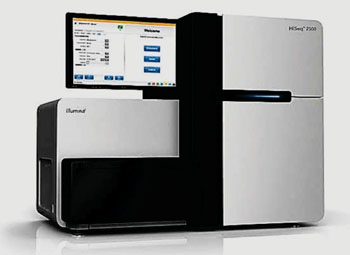Novel Diagnostic Technology Rapidly Identifies Cancer Source
By LabMedica International staff writers
Posted on 28 Oct 2015
A substantial proportion of cancer cases present with a metastatic tumor and require further testing to determine the primary site; many of these are never fully diagnosed and remain cancer of unknown primary origin (CUP).Posted on 28 Oct 2015
A diagnostic method for determining the primary site of the cancer combines genetics and computer science, and can analyze a biopsy from a metastasis, and on this basis provide a number of possible scenarios for where the cancer may have developed and indicate the probability of it being correct.

Image: The HiSeq 2500 ultra-high-throughput sequencing system (Photo courtesy of Illumina).
Scientists at the Technical University of Denmark (Lyngby, Denmark) in collaboration with their international colleagues, used the Catalogue of Somatic Mutations in Cancer (COSMIC) version 68 Whole Genomes database to identify tumor specimens with genome-wide or exome-wide somatic point mutation data, and focused on solid non-central nervous system (CNS) tumors of the ten primary sites for which at least 200 unique specimens were available. The newly developed method, which the team is calling TumorTracer, is based on analyses of DNA mutations in cancer tissue samples from patients with metastasized cancer.
The data set consisted of 7,769 specimens from 28 different primary sites. Some samples were paired-end multiplex sequenced on the HiSeq 2500 (Illumina, San Diego, CA, USA). The pattern of mutations was analyzed in a computer program which had been trained to find possible primary tumor localizations. The method has been tested on many thousands of samples where the primary tumor was already identified, and it has proven extremely precise. The next step will be to test the method on patients with unknown primary tumors. In recent years, scientists have discovered several ways of using genome sequencing of tumors to predict whether an individual cancer patient will benefit from a specific type of medicine.
Aron Charles Eklund, PhD, a professor and senior author of study, said, “We are very pleased that we can now use the same sequencing data together with our new algorithms to provide a much faster diagnosis for cancer cases that are difficult to diagnose, and to provide a useful diagnosis in cases which are currently impossible to diagnose. At the moment, it takes scientist two days to obtain a biopsy result, but we expect this time to be reduced as it becomes possible to do the sequencing increasingly faster, and it will be straightforward to integrate the method with the methods already being used by doctors.” The study was published on October 1, 2015, in the journal BMC Medical Genomics.
Related Links:
Technical University of Denmark













